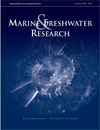Marine and Freshwater Research
Volume 63
Number 9 2012
Given the iconic status of abalone in New Zealand, our understanding of the ontogeny of habitat use in these species is disappointing. We provide a detailed examination of the physical and biological habitat characteristics favored by Haliotis iris in central New Zealand. Our results show the profound influence that habitat variability can have on demographic variability in abalone.
Recent reviews highlight the need for an improved understanding of the mechanisms by which land-use alters river habitats and biota. In this study, biological, physical and land-use data were used to quantify the relationships between land-use and benthic macroinvertebrates in Tasmania, Australia. The analysis demonstrates that the changes in ecosystem function and processes driven by grazing land use are major, with substantial losses of macroinvertebrate families occurring across many Tasmanian catchments.
Plants that release allelochemicals may kill or impair the growth of neighbouring species, allowing them to invade and overwhelm environments. Chemical loads contributed from leaves and rhizomes of Phragmites australis were found to be high and these chemicals tended to persist in soil through anaerobic condition. The use of chemicals by plants may severely alter the floristics of vegetation in both the short and long term.
Floodplain waterbodies provide dry-season refugia for biota and are important asset for remote Aboriginal communities in the wet–dry tropics of northern Australia. We examined seasonal changes in water quality and aquatic plant cover of floodplain waterholes, and related changes to variation of waterhole depth and visitation by livestock. The present study highlights the critical role of hydrological connectivity in floodplain waterholes.
A new multimetric index (MIBIIN) according with the European Water Framework Directive has been developed to assess the ecological status of Mediterranean transitional waters. MIBIIN is salinity-type specific, based on invertebrates and focussed on coastal lagoons. MIBIIN has been tested in the Balearic Islands (eastern Mediterranean Sea) and we recommend it be tested in other Mediterranean coastal lagoons.
The development of acoustic transmitters and static underwater receivers is enabling researchers to monitor the finite to broad-scale movements of aquatic animals over multiple years. The sheer scale and spatial complexity of these datasets, however, are beyond the capabilities of routine spread-sheet applications. Here, we describe software (V-Track) that greatly facilitates the assimilation, analysis and synthesis of acoustic telemetry detection data.
Understanding the flexibility of survival traits is needed to predict outcomes of prolonged stream drying during drought. Aestivation survival of larval caddisflies in moist versus dry sediment was measured: survival was significantly lower in dry sediment. Aestivation is a robust drought survival trait, but prolonged drying will increase larval mortality, potentially leading to local extinction of populations.
Sea lamprey belong to an ancient lineage of migratory jawless fishes. This study shows that threatened European populations are younger and less genetically diverse than North American populations, suggesting that Europe was colonised from North America. It appears European populations have maintained genetic diversity despite reductions in population size from overfishing, blockage of migration routes and alteration of spawning habitat.
The small freshwater shrimp Paratya australiensis is a conspicuous component of coastal streams in eastern Australia, and its ‘role’ in the stream ecosystem has not been previously studied. We studied the effects of shrimps on bottom sediments and algae by excluding them from small quadrats using an electric fence charger and measuring the accumulation of material and chlorophyll. In quadrats where shrimp were excluded, organic matter increased compared with control quadrats, and we conclude that this species is important for ‘cleaning’ rocky substrate and assimilating primary production.




